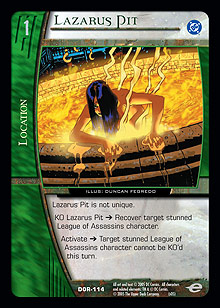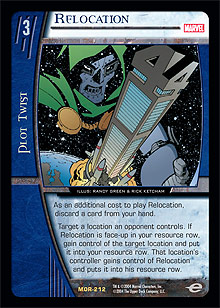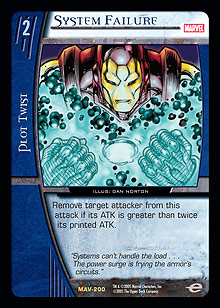
Hi All,
I’m back home after the Good Times that were PC Indy, and I would like to start by thanking everybody who came up and said hi. It’s great to put faces to names, and your support was much appreciated.
I’ve waded through the backlog and once more have an empty mailbag for you to fill, so please keep your rules questions coming into vsrules@gmail.com. And for your chance to win three boosters of the latest expansion, don’t forget to include your name, mailing address, and UDE number. Simple as that.
This week’s winner asks a couple of questions about some older cards, so the plan for this column is to start at Origins and ultimately build up to a crescendo of Avengers hotness. Without further ado . . .
I control exactly four exhausted non-stunned characters and play Press the Attack. If I play another Press the Attack in response, do I get to ready two characters, or just one?
Moses D., Panama City, Panama
You get to ready two characters (or the same character twice, depending on the targets you choose). Press the Attack only checks for four or more exhausted non-stunned characters when you play the effect. It does not recheck on resolution.
I’m playing against Sinister Syndicate with my League of Assassins deck. It’s my opponent’s initiative, and he attacks Merlyn, Archer Assassin with Venom, Eddie Brock. After the attack concludes, am I able to use Lazarus Pit’s second power on my stunned Merlyn before choosing to pay Venom’s 6 endurance?
Moses D., Panama City, Panama
 Yep, that works. Venom’s triggered effect goes on the chain after the attack concludes. After your opponent passes, you may respond by using Lazarus Pit’s second power. After successive passes, its effect resolves, making Merlyn unable to be KO’d.
Yep, that works. Venom’s triggered effect goes on the chain after the attack concludes. After your opponent passes, you may respond by using Lazarus Pit’s second power. After successive passes, its effect resolves, making Merlyn unable to be KO’d.
After further successive passes, Venom’s triggered effect resolves, and you choose whether or not to pay 6 endurance. Because Lazarus Pit’s effect has resolved, Merlyn cannot be KO’d even if you choose not to pay 6 endurance.
I control a stunned Ra’s Al Ghul, Immortal Villain and use Lazarus Pit’s second power on it before recruiting Ra’s Al Ghul, The Demon’s Head. Does Immortal Villain avoid getting KO’d by uniqueness?
Captain Spud and DDylan45
No he doesn’t, because the uniqueness rule doesn’t KO Immortal Villain but rather “puts him into your KO’d pile.” The uniqueness rule specifically uses those words so modifiers like Lazarus Pit’s don’t stop it from working.
An opponent targets my Genosha with Ka-Boom! If I activate and KO Genosha in response, does Ka-Boom! get KO’d?
DDylan45
No, the entire effect is negated because all of its targets are no longer legal on resolution. Ka-Boom! stays face up in your opponent’s resource row.
I activate and KO Genosha. Can my opponent respond by targeting it with Relocation?
Messiah G.
 No, your opponent can’t actually play Relocation in this scenario, at least not one targeting that particular Genosha. You KO Genosha as a cost of playing its effect, then retain priority to play more effects. Your opponent doesn’t get priority until you pass. When you do, he or she can play effects before you draw cards from the resolution of the Genosha effect, but the opponent can’t target the Genosha you KO’d because it’s already in your KO’d pile.
No, your opponent can’t actually play Relocation in this scenario, at least not one targeting that particular Genosha. You KO Genosha as a cost of playing its effect, then retain priority to play more effects. Your opponent doesn’t get priority until you pass. When you do, he or she can play effects before you draw cards from the resolution of the Genosha effect, but the opponent can’t target the Genosha you KO’d because it’s already in your KO’d pile.
I control Danger Room and my opponent targets it with Global Domination. Does his Global Domination negate both Danger Room effects, or just one?
Michael F.
This is a question where terminology is particularly important. Global Domination does not target a location; it targets a location effect on the chain. Danger Room, however, has only continuous powers that generate modifiers without using the chain. As a result, if Danger Room is the only face-up location in play, your opponent cannot actually play Global Domination.
Examples of locations that generate payment effects are Lazarus Pit and Genosha. An example of a location that generates a triggered effect is Playroom.
I control Natasha Romanoff ◊ Black Widow, Super Spy and Hank Pym ◊ Ant Man and team attack into an opponent’s 2-drop. Then I flip up Playroom. When the 2-drop becomes stunned, I target a 3-drop with Natasha’s effect. Does my opponent lose an additional 4 endurance from Playroom’s power when the 3-drop becomes stunned since Natasha is a team-attacker?
Tim K., Brooklyn NY, USA
Nope. Like Sinestro, Green Lantern of Korugar, Natasha’s triggered effect doesn’t go on the chain until after the attack concludes, by which time she has lost the team-attacker characteristic.
In addition, at no time is the 3-drop a defender, which is another reason why Playroom’s power won’t trigger.
Can you please discuss the differences between System Failure and Overload for new players like myself? For example, if an attacker is removed from an attack before it exhausts, it can just attack again, right? But if you remove it after it exhausts to attack, it stays exhausted?
Jonas Y.
 First of all, after you propose an attack with a character but before it exhausts, that character is not an attacker, but rather a “proposed attacker.” So, you can’t target it with System Failure.
First of all, after you propose an attack with a character but before it exhausts, that character is not an attacker, but rather a “proposed attacker.” So, you can’t target it with System Failure.
Only after a character exhausts and becomes an attacker can you target it with System Failure, and that character will indeed stay exhausted after it is removed from the attack.
The Avengers FAQ has this to say on the differences between System Failure and Overload:
Unlike Overload, you may target any attacker with System Failure, regardless of its ATK. However, on resolution, if the target’s ATK is not greater than twice its printed ATK, the effect will resolve but do nothing.
I control Supreme Sanction and play Heroes in Reserve. Can I reveal one or more character cards in my resource row that don’t have reservist printed on them?
Jonas Y.
Yep, that works.
If a character card with the reservist keyword is somehow revealed while in your resource row (by The Demon, Jason Blood, for example), can you still recruit it? The rules say you recruit a reservist card from your resource row by first revealing it. Can you recruit it if it’s already revealed?
Brad H.
With cards like Black Panther and Avengers Mansion, which say to “reveal any number of face-down resources you control,” what happens to the revealed resources? Do they turn back down or stay face up?
Doug
My first thought was that they stay face up, but that would make Avengers Mansion kinda poor, so I wasn’t sure.
Amit S.
The answer to this very popular question is basically that a character card in your resource row never stays revealed. Whenever you reveal a face-down resource, that resource returns to being unrevealed immediately afterward if nothing else happens.
I’m playing Avengers against Teen Titans. I discard a card to use Scarlet Witch, Mistress of Chaos Magic’s power. My opponent responds with a bunch of Roy Harper ◊ Arsenal silliness. When he’s done adding effects to the chain, I discard another card to put Scarlet Witch’s effect on the chain again. What happens?
Steven B., NY, USA
Your opponent’s effects resolve normally. Scarlet Witch’s power stops your opponents from using character payment powers after it resolves. However, your opponents are completely free to use such powers while her effect is on the chain, as your example demonstrates. When her effect resolves, it has no impact on any payment effects your opponents have already put on the chain.
When the combat phase begins, is it immediately the attack step of the initiative player, or is there a point before the first attack step begins (or any phase with steps in it)?
Dan
There is indeed a “priority point” in the combat phase before the initiative player’s attack step begins. For example, if your opponent has the initiative and controls Blizzard, you may use the payment power of Scarlet Witch, Mistress of Chaos Magic after the combat phase begins but before your opponent’s attack step to “shut down” Blizzard.
(And yes, there’s also a priority point in the build phase before the initiative player’s resource step begins.)
So, with that little morsel of tech goodness, it’s time to roll the end credits on another column. Till next time, remember that email address: vsrules@gmail.com.